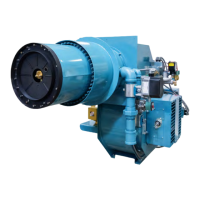Page 22
SC Manual
Startup and Operating Adjustments
g. When the prepurge sequence is complete and the
low re start switch (if used) is made, the pilot valve
will open and the pilot ame should be visible
through the burner sight port.
h. When the pilot ame is established, the ame
safeguard will energize the main valves (indicated
with the Fuel Valve Light), and the burner should
ignite at low re. This operation of the fuel valves
must be visually checked by observing the valve
stem moving up with a motorized valve or hearing
the clicking noise from a solenoid valve.
NOTE: If the burner is not operating as indicated,
follow the troubleshooting steps to determine the
problem and corrective action.
i. The main ame may not light on the rst attempt,
because it must ll the oil lines before providing oil
to the nozzle. Press the reset button on the ame
safeguard to restart the burner.
j. In a few seconds, the combustion analyzer should
have an accurate reading of the O
2
in the stack. The
O
2
level should be between 4% and 7%, and the
nozzle oil pressure should be between 50 and 70
PSIG return line pressure. Do not attempt to ne
tune combustion until the high re has been set.
WARNING
DO NOT ATTEMPT TO START THE BURNER WHEN EXCESS OIL
HAS ACCUMULATED, WHEN THE UNIT IS FULL OF VAPOR, OR
WHEN THE COMBUSTION CHAMBER IS HOT.
5. Air Atomized, #2 Oil Setup
The air atomized oil system has the potential for a large
turndown range similar to gas and has the potential to be
adjusted to different low re rates. See the burner nameplate
for details on actual rates for this burner.
a. Place the burner switch in the “OFF” position.
b. Place the burner management system in manual mode.
c. Place the burner management system in the low
re position.
d. Turn the electrical power for the burner, boiler and
related components on.
e. Verify that the oil metering valve is at the nearly
closed position.
f. Turn the burner switch “on”. This will start the blower
motor and initiate the purge cycle.
g. When the prepurge sequence is complete and the
low re start switch is made, the pilot valve will open
and the ame should be visible through the sight port.
h. When the pilot ame is established, the ame
safeguard will energize the main oil valves
(indicated with the Fuel Valve Light), and the burner
should ignite at low re. This operation of the main
fuel valves must be visually checked by observing
the valve stem moving up with a motorized valve or
hearing the clicking noise from a solenoid valve.
NOTE: If the burner is not operating as indicated,
follow the troubleshooting steps to determine the
problem and corrective action.
WARNING
DO NOT ATTEMPT TO START THE BURNER WHEN EXCESS
OIL HAS ACCUMULATED, WHEN THE UNIT IS FULL OF
VAPOR, OR WHEN THE COMBUSTION CHAMBER IS HOT.
i. After a few seconds, the combustion analyzer
should have an accurate reading of the O
2
in the
stack. The O
2
level should be between 4% and 7%
(see Figure I-1 for O
2
rates), and the nozzle oil
pressure should be between 5 and 15 PSIG. Do not
attempt to ne tune combustion until the high re
input has been set.
• The air damper should be positioned for the
correct low re settings.
• The atomizing air pressure can be adjusted
using the air bleed valve.
j. Operate the burner until the boiler is warmed
up and near the operating pressure or temperature.
k.Increase the ring rate, using the manual
potentiometer, while monitoring and adjusting the
O
2
level. Adjust the oil pressure and atomizing
air pressure as needed to reach high re position.
k. Operate the burner until the boiler is warmed up
and near the operating pressure or temperature.
l. Increase the ring rate, using the potentiometer or
put the low re hold switch in auto position, while
monitoring and adjusting the O
2
level.
m. At high re (end of the modulating motor travel),
adjust the high re input (open or close the fuel
valve) to match the maximum input and/or pressure
listed on the rating label. The fuel metering valve
should be nearly closed (or closed) at this point and
the nozzle pressure should be at the pressure rating
indicated on the rating label (return line) for the SC.
n. Modulate the burner to low re, adjusting the O
2
level as the burner modulates.
p. Adjust the low re input and air damper adjustments.
q. Re-adjust midre points for correct emission levels.
r. Adjust the NOx levels at low and midre rates to
be about 10% under the guaranteed levels or as
required for the gas ring.
s. The burner should be operating at low re to adjust
the air proving switch. Turn the adjusting screw cw
(in) until the burner trips out (shutdown caused by
the air ow switch). Turn the adjustment screw ccw
(out) 1 ½ turns from the point of shutdown. Check
the operation at higher rates.
t. Adjust the oil pressure switch to trip and shutdown
the burner at a pressure that is 10% lower than the
supply oil pressure.

